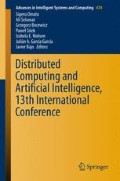Abstract
Wearable sensors based activity recognition is a research area where mostly inertial measurement unit based information is used to recognize human activities. Commonly the approaches are based on accelerometer data while in this study the potential of electromyogram signals in activity recognition is studied. The actual research problem tackled is one of the major drawbacks in activity recognition, namely to add completely new activities in real life to the recognition models. In this study, it was shown that in gym settings electromyogram signals clearly outperforms the accelerometer data in recognition of completely new sets of gym movements from streaming data even though the sensors would not be positioned directly to the muscles trained.
Access this chapter
Tax calculation will be finalised at checkout
Purchases are for personal use only
Preview
Unable to display preview. Download preview PDF.
References
Myo. https://www.myo.com/ (accessed: October 30, 2015)
Banos, O., Damas, M., Pomares, H., Prieto, A., Rojas, I.: Daily living activity recognition based on statistical feature quality group selection. Expert Systems with Applications 39(9), 8013–8021 (2012)
Bulling, A., Blanke, U., Schiele, B.: A tutorial on human activity recognition using body-worn inertial sensors. ACM Comput. Surv. 46(3), 33:1–33:33 (2014). http://doi.acm.org/10.1145/2499621
Chang, K., Chen, M., Canny, J.: Tracking free-weight exercises. In: UbiComp 2007: Ubiquitous Computing, pp. 19–37 (2007)
Cheng, H., Sun, F., Griss, M., Davis, P., Li, J., You, D.: Nuactiv: recognizing unseen new activities using semantic attribute-based learning. In: Proceeding of the 11th Annual International Conference on Mobile Systems, Applications, and Services, MobiSys 2013, pp. 361–374. ACM, New York (2013). http://doi.acm.org/10.1145/2462456.2464438
Devijver, P.A., Kittler, J.: Pattern recognition: A statistical approach, vol. 761. Prentice-Hall, London (1982)
Duda, R.O., Hart, P.E., Stork, D.G.: Pattern classification. John Wiley & Sons (2012)
Holviala, J., Kraemer, W., Sillanpää, E., Karppinen, H., Avela, J., Kauhanen, A., Häkkinen, A., Häkkinen, K.: Effects of strength, endurance and combined training on muscle strength, walking speed and dynamic balance in aging men. European Journal of Applied Physiology 112(4), 1335–1347 (2012). http://dx.doi.org/10.1007/s00421-011-2089-7
Koskimäki, H.: Avoiding bias in classification accuracy - a case study for activity recognition. In: IEEE Symposium on Computational Intelligence and Data Mining (2015) (accepted)
Koskimäki, H., Huikari, V., Siirtola, P., Laurinen, P., Röning, J.: Activity recognition using a wrist-worn inertial measurement unit: a case study for industrial assembly lines. In: The 17th Mediterranean Conference on Control and Automation, pp. 401–405 (2009)
Koskimäki, H., Siirtola, P.: Recognizing gym exercises using acceleration data from wearable sensors. In: 2014 IEEE Symposium on Computational Intelligence and Data Mining (CIDM), pp. 321–328. IEEE (2014)
Morris, D., Saponas, T., Guillory, A., Kelner, I.: Recofit: using a wearable sensor to find, recognize, and count repetitive exercises. In: Proceedings of ACM CHI (2014)
Muehlbauer, M., Bahle, G., Lukowicz, P.: What can an arm holster worn smart phone do for activity recognition?. In: 15th Annual International Symposium on Wearable Computers (ISWC), pp. 79 – 82 (2011)
Peng, H., Long, F., Ding, C.: Feature selection based on mutual information criteria of max-dependency, max-relevance, and min-redundancy. IEEE Transactions on Pattern Analysis and Machine Intelligence 27(8), 1226–1238 (2005)
Siirtola, P.: Recognizing human activities based on wearable inertial measurements: methods and applications. Doctoral dissertation, Department of Computer Science and Engineering, University of Oulu (Acta Univ Oul C 524) (2015)
Siirtola, P., Koskimäki, H., Huikari, V., Laurinen, P., Röning, J.: Improving the classification accuracy of streaming data using sax similarity features. Pattern Recognition Letters 32(13), 1659–1668 (2011)
Stiefmeier, T., Roggen, D., Tröster, G., Ogris, G., Lukowicz, P.: Wearable activity tracking in car manufacturing. IEEE Pervasive Computing 7(2), 42–50 (2008)
Zhang, M., Sawchuk, A.A.: Human daily activity recognition with sparse representation using wearable sensors. IEEE Journal of Biomedical and Health Informatics 17(3), 553–560 (2013)
Author information
Authors and Affiliations
Corresponding author
Editor information
Editors and Affiliations
Rights and permissions
Copyright information
© 2016 Springer International Publishing Switzerland
About this paper
Cite this paper
Koskimäki, H., Siirtola, P. (2016). Recognizing Unseen Gym Activities from Streaming Data - Accelerometer Vs. Electromyogram. In: Omatu, S., et al. Distributed Computing and Artificial Intelligence, 13th International Conference. Advances in Intelligent Systems and Computing, vol 474. Springer, Cham. https://doi.org/10.1007/978-3-319-40162-1_21
Download citation
DOI: https://doi.org/10.1007/978-3-319-40162-1_21
Published:
Publisher Name: Springer, Cham
Print ISBN: 978-3-319-40161-4
Online ISBN: 978-3-319-40162-1
eBook Packages: EngineeringEngineering (R0)

